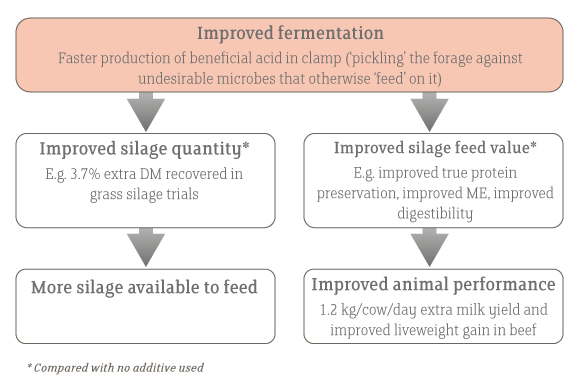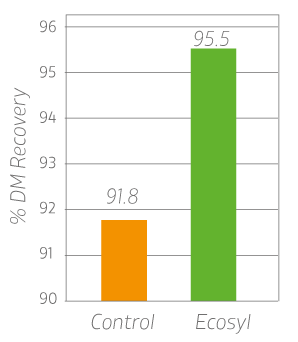Can additive gains help future-proof farms?
28 January 2022
With the need to maximise milk and meat from forage, has the case for using an additive become more compelling?
_original.jpg?1643359369)
Our answer, of course!
Using a proven silage additive
With so many treatments available, the additive should come with clear proof.
The choice should be based on trials conducted under conditions that mimic the weather and crops of the UK, that prove reduction in dry matter losses and animal performance responses.
Effective fermentation in the clamp
Although in theory, fermentation happens naturally when grass is ensiled, due to naturally-occurring bacteria on the crop, the reason for using a proven additive is because some of those bacteria won’t necessarily be the best types to carry out the fermentation efficiently, and some could be very much the wrong types.
To put it simply, you need to direct the fermentation because you can’t guarantee what microbes are present.
To use an analogy, when milk is processed it is sterilised first. But grass isn’t sterilised when it goes in the clamp. If you use the right additive, you will improve sugar content and reduce true protein degradation in the silage.
In the animal, the most inefficient part of rumen fermentation occurs because of low sugar and because protein has been broken down. If you improve these two, you will get an animal performance benefit.
Improve animal performance with a proven silage additive
Dr Mark Leggett, silage microbiologist for British-based additive manufacturer, Volac, agrees. He believes a key reason some farmers remain sceptical about additive use is a lack of awareness and belief in exactly what they do in the clamp.
Fermentation is simply a form of pickling,” says Mark. “An efficient fermentation occurs when good bacteria convert some of the sugars in the forage into beneficial acid, which in turn preserves the forage against undesirable microbes, such as enterobacteria and clostridia.
Applying a quality additive essentially provides an avalanche of specially-selected good bacteria – as many as 1 million per gram of forage when used correctly.
So it puts you in greater control of the fermentation process. Without this, you’re leaving fermentation to chance. If silage is fed for half the year, that’s a big risk.
Pointing to Lactobacillus plantarum MTD/1, the bacterium used in Ecosyl, Mark says there is now a huge amount of research to pinpoint the logical sequence of benefits that treatment brings – from application right through to animal performance (see graphic).
First among these, he says, is improved fermentation efficiency. “There’s a much faster production of beneficial acidic conditions in the first 24 hours after ensiling with treatment than without. That’s an important timescale for stopping bad bugs getting established,” he confirms.
Following this, he says, are increases in silage quantity and quality. “In grass trials, over 95% of the original dry matter ensiled was retained with treatment – 3.7% more than without treatment.
From a quality perspective, Ecosyl treatment has also been shown to boost average ME by 0.6 MJ/kgDM, to preserve more true protein, and to improve digestibility by an extra 3 D units.
“If you’re looking to make more from forage, these improvements offer a logical explanation behind the improvements in animal performance also seen. Across a range of forages in 15 independent trials, seven in the UK and Ireland, Ecosyl treatment boosted average milk yield by an extra 1.2 kg of milk per cow per day.”
Explore our website to find out more about the Volac range of Ecosyl silage additives.
By making high quality silage, more of the animal’s nutritional requirements can be met from home-produced forage.
This can reduce concentrate use and milk production costs, and maintain a healthier rumen, so reducing metabolic disease – all in all making profitable milk production far more likely.
Sequential benefits of Lactobacillus plantarum MTD/1 (Ecosyl) treatment based on research

Improved dry matter recovery in grass silage following additive treatment (15 trials)

Find out more about the Ecosyl range of proven silage additives.
Let us help you make the most from your silage in 2022 with our latest special offer on Ecosyl and Ecocool - buy 10 get 1 completely free.
Ready to place an order? Contact us today!